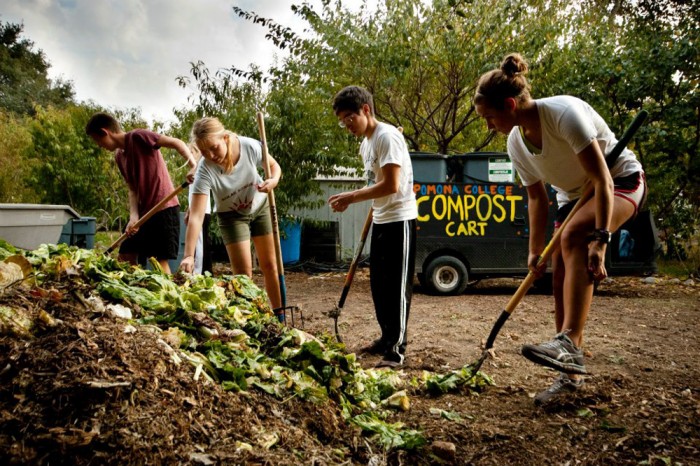Piles, Pitchforks, and Perfect Learning Opportunities: Why Colleges and Universities Should Choose Small-Scale Composting

By Jen Schmidt and Adam Long, Farm Manager at Pomona College, California
In this blog post, Jen and Adam describe the composting program in place at Pomona College and shares their vision on low-tech campus composting.
Shiny, expensive mechanical composters are increasingly popular at colleges and universities that want to compost their food waste, and rightly so. They offer a number of benefits, including reduced labor, minimal odor, and short composting times. At Pomona College, though, we have done things differently and we have come to believe that small-scale, low-technology composting is the way to go. A simple compost pile may not be glamorous, but the educational and environmental benefits of this method are more than worthwhile.
Starting in the mid-1990s, Pomona College students and staff members worked together to compost food waste by hand, that is, manually mixing leaves with food scraps and turning it with pitchforks on an abandoned patch of land on campus. When a formal composting program was finally established in 2009, Pomona College has composted its food waste at the on-campus organic farm. Rather than using expensive, cutting-edge composting machines, we use the simple pile method and do much of the work by hand. This is how simple we do it.
Compostable food scraps (pre- and post-consumer vegan food waste) are picked up from the dining halls by a student worker and transported to the Pomona College Organic Farm on an electric cart. At the “Farm” these food scraps are layered with mulch, leaves, and other campus green waste in a series of three piles, which can be up to six feet tall, ten feet wide, and fifteen feet long. Older compost is mixed in with fresh scraps to introduce the aerobic microorganisms required for composting to occur. The piles reach temperatures of up to 185 degrees Fahrenheit on their own simply from the microbe activity. A small diesel skip-loader (tractor) is used to turn and aerate the piles as they undergo the composting process, providing much needed oxygen to the organisms. After six to eight weeks, the piles begin to cool down and the finished compost is sifted and used to prepare beds for vegetable and fruit production at the Farm. Some compost is donated to community organizations and used in landscaping around the college.
At this point, you might be thinking that this sounds like a lot of work. Why choose such a smelly, dirty, labor-intensive method over a mechanical composter?
Consider the educational opportunities offered by this method. The vast majority of the composting program is run by students, and the physical work of maintaining the piles offers a valuable opportunity to see natural processes of decomposition and nutrient cycling in action. Observing the steam rise off a freshly turned active pile and sifting compost at various stages of the decomposing process with your hands teaches how microorganisms recycle nutrients in a way unmatched by any classroom lecture. Nutrient cycling (or recycling) is what makes compost so popular in organic farming, that is, returning minerals from green waste to the soil, making nutrients available to future crops. That is sustainability. Students who have worked with the compost program at Pomona College come away with a deeper understanding of what sustainability in agriculture really means thanks to their hands-on application of these principles.
Free-standing compost piles use a fraction of the energy of electric composting machines. Small diesel tractors are highly efficient and can run for months on only a few gallons of fuel. Everything else is manual labor.
Though compost piles have their drawbacks, high labor investment chief among them, it is sustainability in its essential and purest form. Our experience with small-scale, low-technology composting has been positive and iconic, and we suggest that other colleges and universities think twice about the educational and environmental potential of the lowly compost pile.